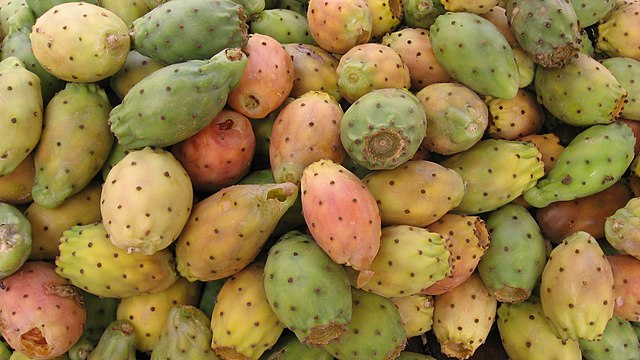As the prickly pear (Opuntia woodsii) season continues, farmers in Qalyubia Governorate, north of Cairo have been busy since July 15, 2024.
In the lead with the harvest is the village of Mit Kanana (also Mit Kinahh) in Qalyubia, a famous source of cactus fruit.
Here, harvesters have been carrying crates full of the orange-yellow ripe fruits while tractors steer along, Ahram news reported.
In fitting fashion, pickers wearing protective clothing such as gloves and hats have been negotiating their way through ripe cactus boulevards harvesting these berries.
Cultural symbol
The July-September harvest attracts young and old alike. In doing so, the harvesters preserve a picking culture preserved since 1980 when national yields stabilized at the 25,000-tonne mark.
Some of the cultural symbols surrounding the fruit is its several English names that have stuck in Egypt. While the most informal is “teen shoky,” popular names include “cactus fruit,” “barbary fig,” and the standard “prickly pear.”
Rich Yields in Middle Egypt
Though Qalyubia is a key source, its yields fall behind those of Middle Egypt’s Minya region, south of Cairo.
Thanks to its hot, dry climate, this governate produces over 1,500 crates from 10 feddans (0.42 hectares), based on 2022 data.
With high yields also come rich earnings from the desert fruit which averages 60 Egyptian pounds ($1.25) per crate. Since a crate contains between 20 to 25 kg of prickly pears, this means the farmer earns 3 EGP ($0.062) per kg.
The wholesale price, on the other hand, rises as it reaches the urban centers such as Minya and Cairo. Most wholesalers or farmers who travel to cities to sell the fruits garner up to 20 EGP ($0.42) a kg.
Consumers usually relish the juicy fruit raw as summer refreshment, although others prefer cactus’ fruit freezes and jam.
In short, as lower Egypt harvests its popular prickly pears, it promises a summer fruit delight for cactus lovers. And as the statistics below reveal, this summer repast is a product of many decades of consistent production.
Egypt Prickly Pear Statistics
As an easy fruit plant to grow, as it thrives under semi-arid conditions, the prickly pear is common across Egypt. Owing to consistent production, output has averaged 25,516.5 tonnes between 1980 and 2016. Over this duration, production peaked in 2011 at 37,290 tonnes and hit rock bottom in 1993 at 8,741 tonnes, per CEIC data.
What products do prickly pears make in Egypt?
Cactus pulp in Egypt is processed into jam and juice, while peel and seeds produce oil and fodder. The products reach both the domestic and international markets. According to Egypt’s Ministry of Environment, local pear oil cold pressing grew by 17% in 2022, surpassing 2021’s growth. Out of every 500 tonnes of raw prickly pears it cold-presses, Egypt targets 43.1 million EGP ($897,773) as turnover.
What is Egypt’s ranking for prickly pears exports?
HS Code 0811 for “Fruit and nuts, uncooked or cooked…” shows that Egypt ranked 8th after Mexico in export value worth $314,713 in 2022. Some of the fruits in this category were prickly pears.
